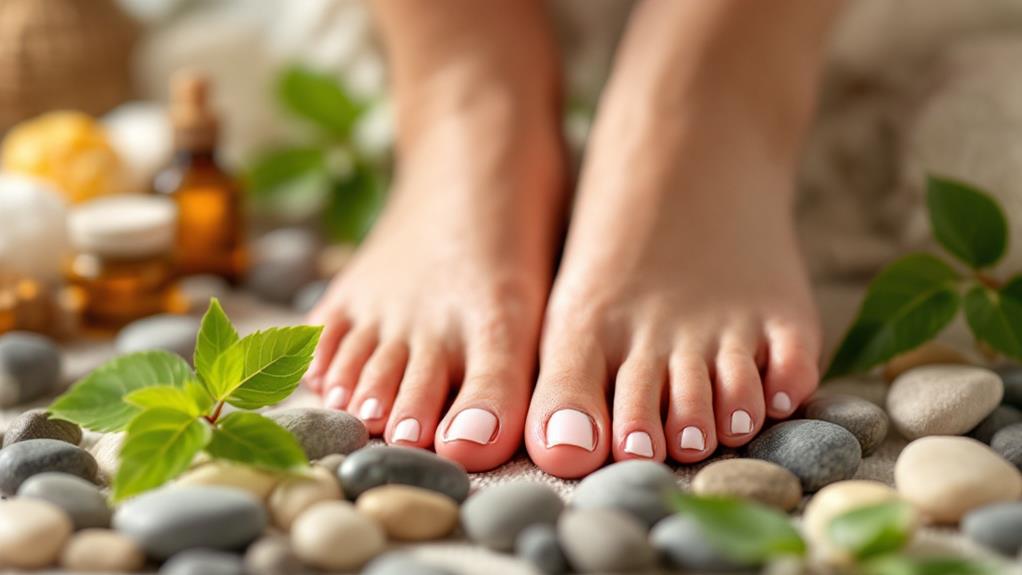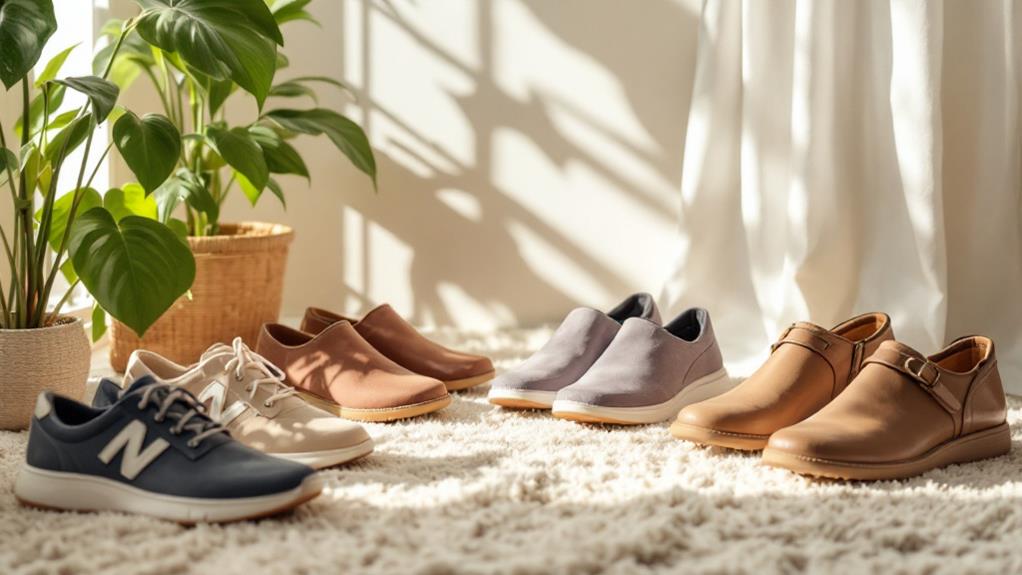Tips for Taking Care of Your Toenails: Healthy Feet, Happy Life

Taking care of your toenails isn't just about looks—it's essential for comfort and general foot health. Cut your toenails straight across after a shower using sharp tools to prevent ingrown nails. Keep feet clean by washing them daily and drying thoroughly to avoid fungal infections. Choose shoes with proper fit and arch support. Inspect your feet weekly for any warning signs. Moisturize regularly, especially around heels, but skip between the toes to prevent fungal buildup. By following these steps, you're on track for healthy feet and a happier life. There's so much more to uncover about thorough foot care.
Proper Toenail Cutting
In relation to proper toenail cutting, it's important to follow a few key practices to maintain foot health and comfort. To prevent ingrown toenails, cut toenails straight across rather than rounding the corners. This simple technique helps you avoid unnecessary pressure and discomfort. When you trim your toenails, it's best done after a shower or bath when they're softer and easier to manage. This reduces the risk of damage and guarantees a clean cut. Use sharp nail clippers or scissors specifically designed for toenails, and consider cutting in small sections for better control, which helps prevent jagged edges.
Maintaining toenail length is significant for healthy foot care. Long nails can cause pressure in shoes, while overly short nails might lead to pain or nail bed injury. After trimming, gently file the edges of your toenails with an emery board to smooth any rough areas that could snag on socks or shoes. Regularly engaging in this practice contributes to effective foot hygiene, preventing foot problems. Ultimately, always wash your feet after cutting your nails to remove any debris and maintain a complete clean and healthy foot environment. Proper toenail cutting is a straightforward step in thorough foot care.
Effective Foot Hygiene
A few daily habits can greatly improve effective foot hygiene. Start by washing your feet with soap and warm water each day. This simple routine helps eliminate harmful bacteria and keeps your feet healthy. Pay extra attention to areas between your toes, as these spots are prone to fungal infections. After washing, thoroughly dry your feet, especially between the toes, to keep moisture away and reduce the risk of issues like athlete's foot.
To maintain peak foot hygiene, change your socks daily. Fresh socks help keep your feet dry and minimize odor. If you're prone to fungal infections, consider applying antifungal powder in your shoes. This extra step can protect your feet from unwanted fungi, ensuring your feet remain happy and healthy.
Avoid sharing footwear, as communal shoes can harbor bacteria and fungi. Accept personal responsibility for your foot health by wearing your own shoes and encouraging others to do the same. Finally, don't forget to trim your toenails straight to prevent ingrown nails, which can be painful and lead to infections. Incorporate regular exercise into your routine to keep your feet strong and resilient. These habits will keep you on the path to happy feet!
Choosing the Right Shoes

Selecting the right shoes is essential for maintaining healthy toenails and general foot comfort. When you choose shoes, make certain there's at least a half-inch of space between your longest toe and the front. This prevents damage to your toenails and avoids discomfort. Pay special attention to the fit and make certain your shoes provide adequate arch support. Proper arch support helps maintain good foot health by distributing pressure evenly, reducing the risk of heel pain and injuries.
Athletic shoes are a great option if you're frequently active. Specialty running stores can evaluate your arch type and gait, helping you find shoes that match your foot mechanics and activity needs. As your feet can widen with maturity, opt for shoes with a wider toe box. This allows for natural movement, preventing issues like blisters or ingrown toenails.
Don't forget to regularly replace worn-out shoes. Over time, shoes lose their support and cushioning, leading to increased strain on your feet and toenails. By selecting the right shoes and keeping them in good condition, you contribute to healthy feet and a happier life. Keep these tips in mind to make certain your feet remain comfortable and well-supported.
Regular Foot Inspections
Your feet are the foundation of your mobility, and regular inspections are vital in keeping them healthy. By conducting regular foot inspections at least once a week, you can easily monitor changes that might indicate potential foot problems. Pay close attention to any swelling, blisters, calluses, cuts, or sores. These early signs might be warning signals of underlying issues that could affect your mobility.
When it comes to toenail health, look for discoloration or signs of ingrown toenails. Ingrown toenails, if left untreated, can lead to infections and complications. Document any changes you notice during your inspections. This information can be valuable when consulting a podiatrist, allowing for early detection and intervention of foot issues.
Don't underestimate the importance of regular foot inspections. They play a significant role in maintaining your complete foot health and preventing complications. By catching problems early, you can guarantee they don't escalate into something more serious. This proactive approach keeps your feet in excellent condition, ultimately supporting your daily activities and preserving your mobility. Remember, healthy feet lead to a happy life, so make these inspections a regular part of your routine.
Hydration and Moisturizing
After you've inspected your feet for signs of potential problems, it's crucial to focus on keeping them hydrated and well-moisturized. Regularly moisturizing, especially around your heels and toes, can prevent dry skin and cracking, which often lead to discomfort and even infections. To achieve ideal hydration, use creams or lotions specifically designed for foot care. These products typically contain ingredients that provide deeper hydration compared to regular body lotions, making them more effective for foot health.
At night, apply a thicker cream to improve hydration while you sleep. This method allows the cream to penetrate deeply, which is especially beneficial if you suffer from extremely dry skin. However, when moisturizing, avoid applying lotion between your toes. Excess moisture in this area can lead to fungal infections, an issue that compromises foot health.
Consistent hydration not only improves the appearance of your toenails but also maintains skin elasticity, thereby preventing calluses. By integrating moisturizing into your daily routine, you support comprehensive foot health, ensuring your feet stay comfortable and infection-free. With proper care, you're more likely to enjoy healthy feet—and a happier life.




